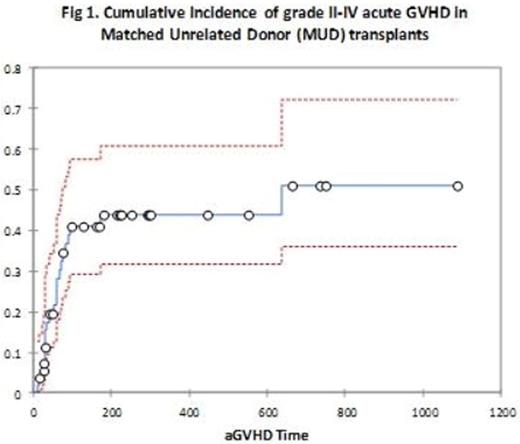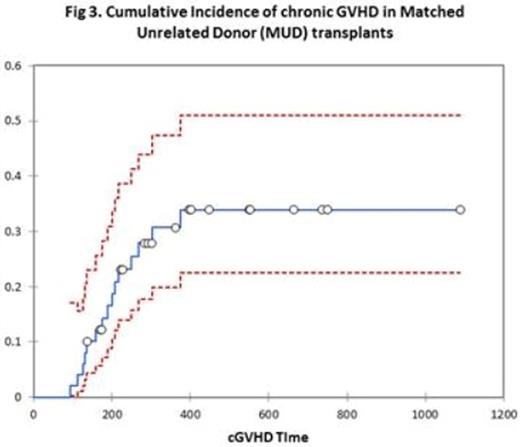Abstract
ATG appears to reduce the incidence of acute and chronic GVHD after allogeneic hematopoietic stem cell transplantation (HSCT). Potential risks of this strategy include viral reactivation, delayed immune recovery and increased relapse rates. The ideal dosing of rabbit ATG in this context is largely unknown. We therefore hypothesized that low dose ATG would reduce the incidence of acute and chronic GVHD in matched unrelated donor (MUD) transplants without compromising survival and relapse rate. A retrospective analysis was performed of a cohort of high-risk MUD HSCT recipients treated since year 2013, when our practice changed to include rabbit ATG at 3 mg/Kg for all MUD transplants at the Case Medical Center in Cleveland, Ohio. Herein we present the results of this analysis.
Methods. 58 MUD transplants were performed between years 2013 and 2016, with a median follow up of 262 days post-transplant. All donor-recipient pairs were matched by high resolution HLA typing at HLA-A, -B, -C, and DRB1, (8/8 matches) with the exception of 4 pairs (7/8 matches. Median age was 56 years (range, 53-64). Underlying diagnoses were AML (n=26), MDS (13), CML (n=5), NHL (n=9), Hodgkin's lymphoma (n=2), Multiple Myeloma (n=1) and myeloproliferative disorders (n=2). Preparative regimens were ablative in 26 cases (45 %) and of reduced intensity in 31 cases (55 %). Graft source was bone marrow (n=5) and peripheral blood (n=53). All but 4 pts received GVHD prophylaxis with tacrolimus, and mini-methotrexate (5 mg/m2 on days +1, +3, +6 and +11), in addition to rabbit ATG 3 mg/Kg divided in two doses on days -2 and -1 pre HSCT. Cytomegalovirus (CMV), Epstein-Barr virus (EBV), and Human Herpes Virus (HHV6) PCR were conducted thrice weekly during the first 100 days after HSCT.
Results. The 100-day cumulative incidence of grade II-IV acute GVHD was 41% (95% CI: 29-57; Fig 1), while the cumulative incidence of grade III-IV acute GVHD was 18% (95% CI: 9-35; Fig 2). 1-year cumulative incidence of chronic GVHD was 27% (95% CI: 17-42; Fig 3). At 180 days, the incidence of CMV viremia (defined as more than 1,000 copies/mL) was 25% (95% CI: 16-40), while the incidence of EBV and of HHV6 viremia was 35% (95% CI: 24-51) and 14% (95% CI: 8-27), respectively. There was no instance of EBV-related lymphoproliferative disorder.
3-year overall survival estimate is 48% (95% CI: 34-62). Cumulative incidence of Non-relapse mortality (NRM) and relapse at 1 year was 21% (95% CI: 12-37) and 44% (95% CI: 29-65), respectively.
Conclusion. Our study shows that low dose rabbit ATG appears to reduce chronic GVHD rates without a major effect on acute GVHD incidence. CMV, EBV and HHV6 reactivation did occur, albeit at rates that are somewhat lower than those historically reported, without EBV-driven lymphoproliferative disorder.
Caimi:Genentech: Speakers Bureau; Roche: Research Funding; Novartis: Consultancy; Gilead: Consultancy.
Author notes
Asterisk with author names denotes non-ASH members.




This feature is available to Subscribers Only
Sign In or Create an Account Close Modal